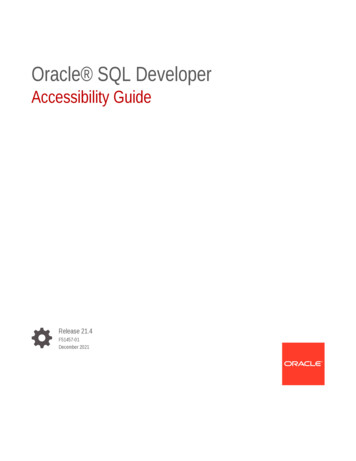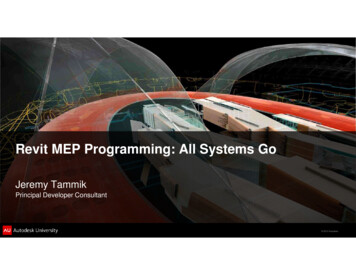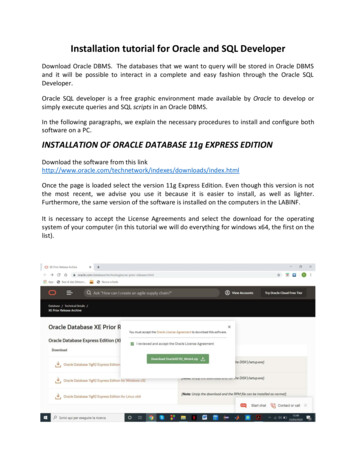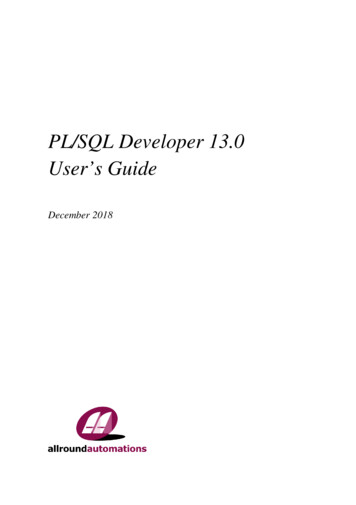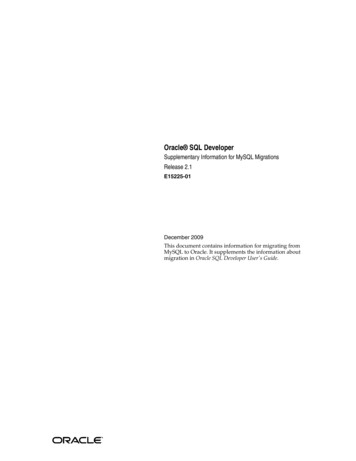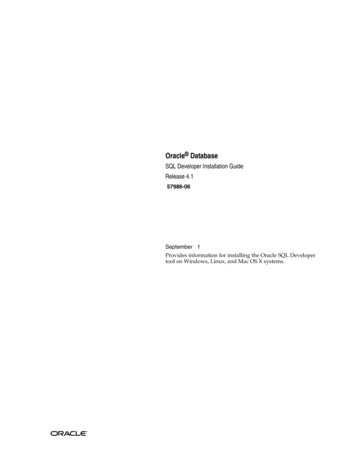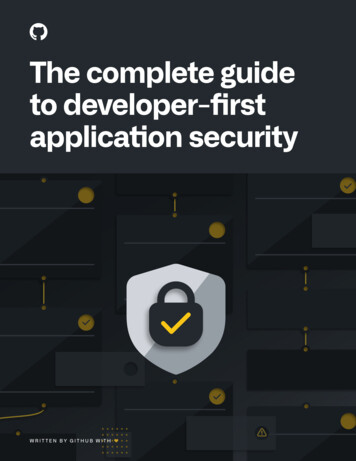
Transcription
The complete guideto developer-firstapplication securityTT EI TGE V ELO P ER- F I R S T A P P L I C AT I O N S EC U R I T YWHREI TCT OEMN PBLYE GHUUIBD EWTI TOH D 1
Contents3Introduction5Executive summary10Part one: State of applicationsecurity today16Part two: Traditional vs.end-to-end security24Part three: Developerfirst application securitywith GitHub33Conclusion
IntroductionT H E C O M P L E T E G U I D E T O D E V ELO P ER- F I R S T A P P L I C AT I O N S EC U R I T Y3
INTRODUCTIONAs a result of globalization and digital transformation,business now runs on ones and zeros. No matter theindustry, high-performing organizations all compete for thesame advantage: Transforming the customer experienceinto a digital-first medium that stands out.Since applications fuel these digital experiences, developingapplications needed to deliver business processes hasbecome a core competency for organizations of all sizes; everycompany is now a technology company. At the same time,enterprise applications’ increasing use and importance createa prime target for malicious actors—resulting in devastatingdata breaches. While it can be difficult to pinpoint the initialattack vector for breaches, in retrospect, many of the biggestrecent breaches are known to have leveraged vulnerabilities atthe application layer.1Given how critical applications are to many businesses—both in terms of the functions they provide and the data theyprocess—why do we keep experiencing application securitybreaches? Despite an emphasis on application developmentand improved application security, application vulnerabilitiescontinue to grow linearly with lines of code. How can we breakthis relationship in order to deliver more secure applications?In this ebook, we’ll take a look at the current state ofapplication security and recommend sustainable solutions.We’ll also share GitHub’s responsibility in securing the world’ssoftware, and how GitHub helps organizations deliver moresecure applications and empower innovation.-------1: 2020 Open Source Security and Risk Analysis Report, SynopsysT H E C O M P L E T E G U I D E T O D E V ELO P ER- F I R S T A P P L I C AT I O N S EC U R I T Y4
ExecutivesummaryT H E C O M P L E T E G U I D E T O D E V ELO P ER- F I R S T A P P L I C AT I O N S EC U R I T Y5
EXECUTIVE SUMMARYPart one: The current stateof application securityApplication security leverages a system of tools, processes,and best practices to manage application-related business risk.Depending on risk appetite and the criticality of applications, as wellas security program maturity, application security can range fromsimple risk awareness to a well-established pipeline that quicklyidentifies and remediates vulnerabilities, ideally pre-production.Modern software is built on open source, but as the adoption ofopen source components increases, so can security risks for bothdevelopers and security teams.For the average organization today, application security consists ofa small set of testing tools integrated with the software developmentcycle. Common current concepts include static application securitytesting (SAST), dynamic application security testing (DAST),passive and active integrated application security testing (IAST),runtime application security protection (RASP), fuzzing, softwarecomposition analysis (SCA), penetration testing, and bug bounties.Depending on an organization’s maturity level, tooling, andcapabilities, application security is either treated as the finalgate before deploying an application, or as a series of testsintegrated with the development cycle.T H E C O M P L E T E G U I D E T O D E V ELO P ER- F I R S T A P P L I C AT I O N S EC U R I T Y6
EXECUTIVE SUMMARYPart two: Traditional vs.end-to-end securityTraditional approach: Security as a gateHaving security as a gate prior to deployment is the most traditionalapproach, and often the first step for organizations just starting withapplication security. This approach consists of security tests thatrun during the quality assurance phase. These tests are providedby security teams or third-party vendors, and the outcomes aredelivered in bulk to developers for remediation with the expectationthat everything will be fixed prior to deploying to production.In this traditional gate approach, SAST, DAST, IAST, and SCA are themost commonly observed security evaluation tools. Although havingsecurity as a gate is better than having no application security atall, this approach causes developer friction and delays in deliveringsecure applications. Late security feedback causes confusion,manual reviews lead to bottlenecks, and scan results have a highnoise-to-signal ratio—all of which lead to developer frustration anddisrupt developer velocity.End-to-end approach: Security integratedinto every step of the development cycleOrganizations that are more mature in application security employan end-to-end approach. This delivers superior results to thetraditional approach by providing developers with feedback ontheir application’s security earlier (“shifting security left”), andT H E C O M P L E T E G U I D E T O D E V ELO P ER- F I R S T A P P L I C AT I O N S EC U R I T Y7
EXECUTIVE SUMMARYleveraging integration and automation capabilities throughoutthe development lifecycle. However, like the shortcomings of thetraditional approach, the end-to-end approach has four mainfriction points:1. Integrations require constant upkeep and frequently break duewith version updates.2. Security teams and development teams still work in silos.3. A utomated tools don't solve the problem of false positives.4. Traditional tools fail to keep up with the pace of thesoftware ecosystem.Relatively newer approaches to application security—includingsecurity in the DevOps lifecycle (sometimes referred to asDevSecOps) and shifting security left—have suggested significantimprovements to the above approaches, but drove little changesince the tools and processes themselves remained stagnant.Part three: Developer-firstapplication security with GitHubTo actually drive down the number of vulnerabilities in productioncode, security teams need to partner with developers in theirpreferred environment and leverage their existing workflows. Puttingdevelopers front and center for application security is the mosteffective way to shift security left and succeed against the mountingtechnical debt that can overwhelm even the best teams.T H E C O M P L E T E G U I D E T O D E V ELO P ER- F I R S T A P P L I C AT I O N S EC U R I T Y8
EXECUTIVE SUMMARYUsing GitHub, your teams can create secure applications with adeveloper-first approach, empowering your developers to sharelessons learned and easily tackle today’s application securityissues. Instead of relying on multiple tools that cause friction,GitHub offers a unified, native, and automated solution alreadyin your developer workflow, and additional security code reviewsduring every step of the development process. Developers getsecurity feedback within the development workflow with supplychain and code security features—including code scanning,Dependabot alerts for vulnerable dependencies and Dependabotsecurity updates, secret scanning, and more. You can addresssecurity risks earlier to automate vulnerability fixes and ship moresecure applications, faster.T H E C O M P L E T E G U I D E T O D E V ELO P ER- F I R S T A P P L I C AT I O N S EC U R I T Y9
Part one: Stateof applicationsecurity todayT H E C O M P L E T E G U I D E T O D E V ELO P ER- F I R S T A P P L I C AT I O N S EC U R I T Y10
PA R T O N E : S TAT E O F A P P L I C AT I O N S E C U R I T Y T O D AYApplication security leverages a system of tools, processes, andbest practices to manage application-related business risk.Depending on the level of risk you’re willing to accept and howcritical your applications are, application security ranges from solelybeing aware of the risks to having well-established processes forquickly identifying and remediating vulnerabilities, ideally beforethey make it into a production environment.Modern software is built on open source. Ninety-nine percentof enterprise codebases contain open source code according toSynopsys’ 2020 Open Source Security and Risk Analysis Report.1But as the adoption of open source components increases, socan security risks for both your developers and security teams dueto increased exposure. For example, projects frequently inheritvulnerabilities from unpatched open source components usedas dependencies. And the likelihood of these risks is rising, withthe 2019 State of the Software Supply Chain Report by Sonatypereporting a “71 percent increase in confirmed or suspected opensource-related breaches in the last five years.”2Before we dive into different approaches to application security, let’sreview some common application security concepts:Static application security testing(SAST)SAST uses application source code or binary code as input, andscans this code for known vulnerable code patterns to generateresults that identify potential vulnerabilities. SAST tools arecommonly used in early to late stages of software development,especially prior to shipping the code to production.-------1: 2020 Open Source Security and Risk Analysis Report, Synopsys2: 2019 State of the Software Supply Chain Report, SonatypeT H E C O M P L E T E G U I D E T O D E V ELO P ER- F I R S T A P P L I C AT I O N S EC U R I T Y11
PA R T O N E : S TAT E O F A P P L I C AT I O N S E C U R I T Y T O D AYSAST tools run multiple analyzers to find potential vulnerabilitiesacross the code, but the inability to validate context andexploitability may lead to “noisy” results. Since scan results arebased on known vulnerability patterns, these results are not highlyaccurate, with many SAST tools generating false positives. Not onlyare scans time-intensive, taking anywhere from hours to weeks, butreviewing raw scan results is a labor-intensive task. Your securityteam or development leads need to validate and prioritize truepositives while removing false positives. This ends up becoming thebottleneck for traditional SAST tools.Dynamic application security testing(DAST)DAST examines a target application’s code to identify its attacksurface, or application tree, and deploys the application ina test environment to run simulated attacks. DAST tools arecommonly used during QA prior to shipping the code, as well as onproduction applications.The process generates raw scan results which point out potentiallyexploitable vulnerabilities, such as those made available via the userinterface. As a result, DAST tools identify a subset of the applicationlayer vulnerabilities reported by a SAST tool, which are known to beexploitable. DAST tools can also find vulnerabilities SAST tools miss,like those related to the running environment of the application(server, frameworks, network). This is why SAST and DAST are usedas complementary methods to comprehensively understand therisk posture of applications. DAST tools validate attack results withserver responses they receive, so scan results need to be manuallyreviewed before fixes are planned.T H E C O M P L E T E G U I D E T O D E V ELO P ER- F I R S T A P P L I C AT I O N S EC U R I T Y12
PA R T O N E : S TAT E O F A P P L I C AT I O N S E C U R I T Y T O D AYIntegrated application security testing(IAST)IAST finds security vulnerabilities by installing an agent which runsalongside the target application. IAST is commonly used duringcontinuous integration (CI) and quality assurance (QA) phases.There are two variants of IAST:Passive IAST is used for applications running in testingenvironments. When the application goes through use case-basedQA tests, the agent identifies potential security vulnerabilities. Thisapproach finds a subset of vulnerabilities that can also be foundusing SAST or DAST.Active IAST is used for applications running in live environmentsand acts as an enhancement for DAST tools. The agent is installedon the running application and performs DAST tests against theapplication. The agent can view stack trace information and can dodetailed behavior analysis on the server side, so the DAST processand results can be improved. Active IAST helps reduce the scanningtime and validate attack results for DAST.Runtime application security protection(RASP)RASP involves installing an active agent on a running applicationand using this agent to protect the application at runtime. Incontrast to other AST tools, RASP tools are used against activevulnerability exploits on applications running in productionenvironments. RASP agents can detect and prevent predefinedT H E C O M P L E T E G U I D E T O D E V ELO P ER- F I R S T A P P L I C AT I O N S EC U R I T Y13
PA R T O N E : S TAT E O F A P P L I C AT I O N S E C U R I T Y T O D AYsets of vulnerabilities, but these agents may degrade applicationperformance, especially under heavy usage, DoS, or DDoS attacks.FuzzingFuzzing (or fuzz testing) uses automated or manual methods toprovide invalid, unexpected, or random data as inputs to runningapplications in a test environment. As these inputs are sent, thetarget application is continuously monitored for exceptions whichmay include crashes, abnormal behavior, or potential memoryleaks. Fuzzing can provide additional information about a targetapplication and serves as a complementary method for DAST.Software composition analysis(SCA)SCA analyzes an application to determine its third-partycomponents, frequently focused on open source software (OSS)security issues and license compliance. SCA is often used in earlyphases of software development.Today’s SCA tools create an inventory of third-party componentsand check these components for known vulnerabilities or otheroperational risks such as license compliance. In some cases,they also offer a library of verified and compliant components fordevelopers to use.Penetration testingPenetration testing involves automated and manual tests that aimto test the security controls of running applications. In most casesT H E C O M P L E T E G U I D E T O D E V ELO P ER- F I R S T A P P L I C AT I O N S EC U R I T Y14
PA R T O N E : S TAT E O F A P P L I C AT I O N S E C U R I T Y T O D AYpenetration tests only cover applications running in production, butthey can also be scoped to cover pre-production environments.Penetration tests can be conducted by internal or external teams,and are typically summarized in reports. The results of thesetests are already validated by the testing team, but penetrationtests require planning and take longer than automated scanningmethods. In addition to technical vulnerabilities, penetration testscan discover faults in the logical flow or user experience of theapplications in scope.Bug bountiesBug bounties are crowd-sourced security testing programs whichleverage individual security researchers who get paid based onthe vulnerabilities that they discover. Bug bounties serve as acomplementary solution to all of the methods noted above, butdon’t typically provide comprehensive coverage for the securityposture of applications.For the average organization today, application security consists ofa small set of testing tools integrated with the software developmentcycle. Depending on your organization’s maturity level, tools, andcapabilities, application security may either be treated as the finalgate before deploying an application, or alternatively as a series ofintegrated tests as part of the development cycle.Let’s take a look at these two approaches and what they mean foryour developers.T H E C O M P L E T E G U I D E T O D E V ELO P ER- F I R S T A P P L I C AT I O N S EC U R I T Y15
Part two:Traditional vs.end-to-endsecurityT H E C O M P L E T E G U I D E T O D E V ELO P ER- F I R S T A P P L I C AT I O N S EC U R I T Y16
PA R T T W O : T R A D I T I O N A L V S . E N D -T O - E N D S E C U R I T YThe traditional approachHaving security as a gate prior to deployment is a commonapproach, and often the first step for organizations just startingwith application security. This “traditional” approach consists ofa single security test or a series of security tests that take placeduring the quality assurance phase. These security tests are run bysecurity teams or third parties, and the outcomes of the securityresults are delivered in bulk to developers for remediation. The tests’findings are then expected to be fixed before the application goesinto production.Application security as a gatePRCode reviewCommitCI / STSCADASTIASTCode / TestCDShipSASTDASTSCAIASTQA &IntegrationtestingT H E C O M P L E T E G U I D E T O D E V ELO P ER- F I R S T A P P L I C AT I O N S EC U R I T Y17
PA R T T W O : T R A D I T I O N A L V S . E N D -T O - E N D S E C U R I T YIn this traditional gate approach, teams most commonly use SAST,DAST, IAST, and SCA tools.Although having security as a gate is better than having noapplication security at all, it causes developer friction and delaysdelivering secure applications. This is due to three main reasons:1. L ate security feedback causes confusion. Security feedbackthat comes at a later stage in development (often weeks afterthe code’s creation) means that developers have already movedon to the following sprint or the next project, so the vulnerablecode in question is no longer top of mind. It can take a while fordevelopers to refamiliarize with the code and context, and thefixes often require additional sprint planning, potentially delayingcurrent projects. “More than 70 percent of all flaws remainone month after discovery and nearly 55 percent remain threemonths after discovery” per the State of Software Security ReportVolume 10 by Veracode.32. S can results have a high noise-to-signal ratio. Traditionalapplication security tools generate multiple false positives forevery true positive, so reviewing scan results is a challengingtask. These reviews are generally done by security teams whohave limited knowledge about the scanned projects, whichmakes auditing scan results difficult and labor-intensive. Anotherapproach is to push raw scan results to developers withoutreviews, but this puts the burden of evaluation onto developers,deprioritizing their effort to actually fix the issue.In both cases, a considerable amount of false positives maketheir way to developers as items to be fixed, causing confusionand frustration.-------3: State of Software Security Report Volume 10, VeracodeT H E C O M P L E T E G U I D E T O D E V ELO P ER- F I R S T A P P L I C AT I O N S EC U R I T Y18
PA R T T W O : T R A D I T I O N A L V S . E N D -T O - E N D S E C U R I T Y3. M anual reviews cause bottlenecks. When scan results aregenerated by automated tools, they still require manual reviewto identify true positives and eliminate false positives. Securityteams are greatly outnumbered by developers and they simplycan’t keep up with the sheer volume of raw scan results that needtheir attention. Manual reviews can take days and even weeks forthe average project, creating a bottleneck and delays in projecttimelines. Delays can be even more frustrating in cases wheremanual review results don’t meet expectations. In most cases,delayed security results mean teams have to ship releases withknown vulnerabilities, with no time to fix these issues to meetproject timelines.Another downside of traditional security is that if a project isn’ta priority, it won’t get manual reviews. “Raw” scan results mayalso be shared directly with developers, which are non-validatedscan results with a high false positive (non-finding) ratio. Sincethese results can quickly become frustrating and developerscan become desensitized to so many false positives, raw scansare either turned off or their results get ignored. Either optionadds more risk to your organization. If security issues aren’taddressed in time, they can become a legal liability—like if asecurity issue is found to be a source of a data breach, or if notremediating a known issue is a breach of one (or more) of yourcustomer contracts.The end-to-end approachOrganizations that are more mature in application securityemploy an end-to-end approach, which starts in earlier stages ofdevelopment and has more points of interaction throughout thedevelopment lifecycle.T H E C O M P L E T E G U I D E T O D E V ELO P ER- F I R S T A P P L I C AT I O N S EC U R I T Y19
PA R T T W O : T R A D I T I O N A L V S . E N D -T O - E N D S E C U R I T YEnd-to-end approachPRIDE nfigurationShipSASTSCACode reviewCI / TestingSASTSCADASTIASTCDDASTCode / TestSAST PenetrationDAST testingSCA Bug bountyQA &IntegrationtestingThe end-to-end approach provides earlier security feedback todevelopers and leverages integration and automation capabilities ofsecurity tools. But like traditional security, end-to-end security stillhas several friction points:1. I ntegrations require a lot of upkeep and frequently breakbecause of version updates. Although security tools areintegrated with the development process, these integrationsbreak often. Developers have to drop their current tasks toaddress a security issue and log into another portal to deal witha different tool or system. Security feedback lacks context andcontext-switching remains a challenge. The user experiencebecomes problematic and inefficient for developers.2. S ecurity teams and development teams continue towork in silos. Changing your tooling isn’t enough to changeT H E C O M P L E T E G U I D E T O D E V ELO P ER- F I R S T A P P L I C AT I O N S EC U R I T Y20
PA R T T W O : T R A D I T I O N A L V S . E N D -T O - E N D S E C U R I T Yyour processes. Silos between the security and applicationdevelopment teams still have to be addressed for end-toend security to work. Integrating tools streamlines part of theapplication security process, but this approach again fallsshort of nurturing more collaboration between security anddevelopment teams.Security teams also still act as reviewers for testing results. Forexample, every commit on the main branch gets scanned andnew alerts are sent to the security team for review. The securityteam still has to triage and send issues back to developers tofix, and the team likely still has a gating process on release. Thisis a better approach than having security tests as a gate sincesome things get caught early, but these teams still lack commonprocesses and platforms to collaborate. With silos and poorcommunication, issues are pushed back and forth betweenteams, often leading to delays and sometimes conflict.3. A utomating traditional tools doesn’t solve the false positiveproblem. It’s exciting to think about automated applicationsecurity tools. But in reality, automating scans and pushingresults to an issue tracker leads to a flood of non-actionableissues. Here the problem is false positives and developersbecoming desensitized to noise. With too many alerts, developersignore test results (and mark them all as “false positives” or“won’t fix”). Traditional security tools lack the customizability toadjust sensitivity or improve results over time, so when results arepushed into developer flows, developers switch these tools off.4. T raditional tools fail to keep pace with the software ecosystem.Today’s software ecosystem consists of open source, newprogramming languages, new frameworks, and emerging toolsthat evolve at a breakneck pace. Since traditional commercialtools are created, updated, and supported by small vendor teams,T H E C O M P L E T E G U I D E T O D E V ELO P ER- F I R S T A P P L I C AT I O N S EC U R I T Y21
PA R T T W O : T R A D I T I O N A L V S . E N D -T O - E N D S E C U R I T Ythey struggle to keep up. There’s also very limited communicationbetween these vendors and the developer community, requiringresearch teams to proactively look for OSS vulnerabilities—anunscalable task with 100 million-plus public repositories. Asa result, most commercial tools do well in a few aspects ofapplication security or limit their support to a small part of thesoftware ecosystem. This means your developers and securityteams either have to work with multiple tools and vendors for asingle use case, or invest in home-grown solutions to fill the gapsthat your commercial tools create.DevSecOps and shifting leftRelatively newer approaches to application security—includingDevSecOps and shifting security left—have suggested significantimprovements to both traditional and end-to-end security. However,they’ve driven little change since the tools and processes remainmostly the same.Even with DevSecOps, traditional and end-to-end securityapproaches still share common problems:1. High friction between developers and security teams,2. A pplications frequently shipped with known vulnerabilities (83percent of applications have one security flaw on initial scan andtwo out of three applications fail to pass tests based on OWASPTop 10 and SANS 253),3. Low fix rates for discovered vulnerabilities (only 56 percent of-------3: State of Software Security Report Volume 10, VeracodeT H E C O M P L E T E G U I D E T O D E V ELO P ER- F I R S T A P P L I C AT I O N S EC U R I T Y22
PA R T T W O : T R A D I T I O N A L V S . E N D -T O - E N D S E C U R I T Ysecurity flaws are fixed, with 24 percent of high-severity flaws leftunfixed by developers3), and4. L ong exposure periods for detected issues (the median time tofix security flaws is 59 days3).With all of these challenges combined, it’s little surprise that webapplications have been reported as the main cause of securitybreaches over the last five years.4-------3: State of Software Security Report Volume 10, Veracode4: 2016, 2017, 2018, 2019 and 2020 Data Breach Investigation Reports, VerizonT H E C O M P L E T E G U I D E T O D E V ELO P ER- F I R S T A P P L I C AT I O N S EC U R I T Y23
Part three:Developer-firstapplication securityT H E C O M P L E T E G U I D E T O D E V ELO P ER- F I R S T A P P L I C AT I O N S EC U R I T Y24
PART THREE:D E V ELO P ER- F I R S T A P P L I C AT I O N S EC U R I T Y W I T H G I T H U BDeveloper-first, community-powered securitywith GitHubUnless security issues can be identified and fixed by yourdevelopers early in the development lifecycle, technical debt willcontinue to be a challenge for your software ecosystem. And likemany other challenges, application security problems are easiestand most cost-effective to solve at the source. To actually drivedown the number of vulnerabilities in production code, we need topartner with developers in their preferred environment and use theirexisting workflows.There’s only one way to shift security left and succeed againstoverwhelming technical debt: Putting developers front andcenter for application security.By prioritizing developers and giving them the tools to work inthe most efficient way, GitHub takes responsibility for makingthe software we all rely on more secure. GitHub creates secureapplications with a community-powered approach that addressesfeedback early and often from developers; empowers researchersto enhance and embellish search capabilities; and crowd-sourcesbug bounty testing programs. Instead of relying on multiple toolsthat cause friction in the process, GitHub offers a unified, native,and automated solution within the developer workflow. You canaddress security risks earlier, automate vulnerability fixes, and havebetter security governance to build and protect applications.T H E C O M P L E T E G U I D E T O D E V ELO P ER- F I R S T A P P L I C AT I O N S EC U R I T Y25
PART THREE:D E V ELO P ER- F I R S T A P P L I C AT I O N S EC U R I T Y W I T H G I T H U BHow to improve your project’s securitywith GitHub1. Start with security in mindReviewing security requirements and identifying potential risks withyour project prior to implementation are critical steps for preventingexpensive vulnerability fixes. Here are a few ways to put theminto practice:Apply security best practices for project configurationConfiguring your project to match security best practices canprevent a lot of problems. Reviewing accounts and access settings(including roles and responsibilities, two-factor authentication, gitover SSH, managing teams, integrations, and projects) along withsetting a SECURITY.md vulnerability disclosure and reporting policycan go a long way.Model threats for the projectSoftware threat modeling is the set of activities that helps identifythe potential threats, threat actors, and vulnerable components ina project. Threat modeling requires analyzing the business logicand flow of sensitive data through library APIs like source and sink.Source is the part of code where data is ingested, and sink is thepart of code where data flow is completed.CodeQL is the industry-leading semantic code analysis enginethat lets you query code as though it were data—making it easy todiscover a bad pattern and then find similar occurrences acrossyour entire codebase. Behind the scenes, CodeQL adaptive threatT H E C O M P L E T E G U I D E T O D E V ELO P ER- F I R S T A P P L I C AT I O N S EC U R I T Y26
PART THREE:D E V ELO P ER- F I R S T A P P L I C AT I O N S EC U R I T Y W I T H G I T H U Bmodeling semi-automatically boosts your JavaScript securityqueries with machine learning to find more security vulnerabilitiesand improve taint specifications. Taint specifications capture therole of library APIs—source and sink—and are a critical componentof any taint analyzer that aims to detect security violations basedon information flow. A boosted query then produces a ranked list ofadditional results for you to review. With adaptive threat modeling,your JavaScript and TypeScript queries will identify more securityproblems. For example, using this technique GitHub Security Labwas able to find 118 new NoSQL injection
attack vector for breaches, in retrospect, many of the biggest recent breaches are known to have leveraged vulnerabilities at . security updates, secret scanning, and more. You can address security risks earlier to automate vulnerability fixes and ship more secure applications, faster.



